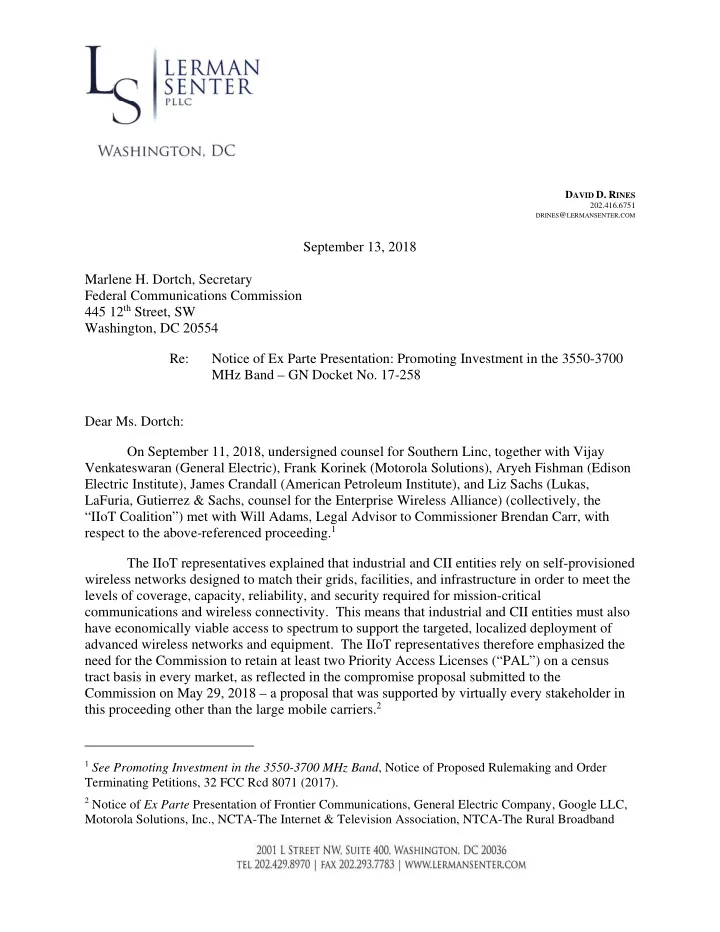

D AVID D. R INES 202.416.6751 DRINES @ LERMANSENTER . COM September 13, 2018 Marlene H. Dortch, Secretary Federal Communications Commission 445 12 th Street, SW Washington, DC 20554 Re: Notice of Ex Parte Presentation: Promoting Investment in the 3550-3700 MHz Band – GN Docket No. 17-258 Dear Ms. Dortch: On September 11, 2018, undersigned counsel for Southern Linc, together with Vijay Venkateswaran (General Electric), Frank Korinek (Motorola Solutions), Aryeh Fishman (Edison Electric Institute), James Crandall (American Petroleum Institute), and Liz Sachs (Lukas, LaFuria, Gutierrez & Sachs, counsel for the Enterprise Wireless Alliance) (collectively, the “IIoT Coalition”) met with Will Adams, Legal Advisor to Commissioner Brendan Carr, with respect to the above-referenced proceeding. 1 The IIoT representatives explained that industrial and CII entities rely on self-provisioned wireless networks designed to match their grids, facilities, and infrastructure in order to meet the levels of coverage, capacity, reliability, and security required for mission-critical communications and wireless connectivity. This means that industrial and CII entities must also have economically viable access to spectrum to support the targeted, localized deployment of advanced wireless networks and equipment. The IIoT representatives therefore emphasized the need for the Commission to retain at least two Priority Access Licenses (“PAL”) on a census tract basis in every market, as reflected in the compromise proposal submitted to the Commission on May 29, 2018 – a proposal that was supported by virtually every stakeholder in this proceeding other than the large mobile carriers. 2 1 See Promoting Investment in the 3550-3700 MHz Band , Notice of Proposed Rulemaking and Order Terminating Petitions, 32 FCC Rcd 8071 (2017). 2 Notice of Ex Parte Presentation of Frontier Communications, General Electric Company, Google LLC, Motorola Solutions, Inc., NCTA-The Internet & Television Association, NTCA-The Rural Broadband
Marlene Dortch, Secretary September 13, 2017 Page 2 The IIoT Coalition representatives stated that the industrial and CII sectors have already made substantial investments in networks and systems that operate in the 3650 MHz band, much of it in expectation of the promised opportunities of the CBRS band and in reliance on the Commission’s assurances that its rules for the CBRS band would not compromise these operations and strand these investments. We explained that industrial and CII entities are fully prepared to bid aggressively for PALs in the CBRS band and to make significant investments to deploy and operate systems in this band, but that the size of the license area has to make economic sense. If PALs were to be made available only on the basis of large geographic areas such as CMAs or even counties, an entity seeking to operate in a limited geographic area – such as the area around an electric generation facility, railyard, port, or manufacturing complex – would be compelled to submit the highest bid for a PAL that covers a substantially larger area, thus foreclosing the PAL as an economically viable option. 3 Conversely, maintaining at least some census tract-based PALs in every market would promote targeted, efficient use of the spectrum and encourage network investment and deployment not just by industrial and CII entities, but by a wide variety of other users as well, and will encourage ongoing innovation and investment in new services, technologies, and use cases that meet important commercial and public interest needs. Finally, we discussed the design of the PAL auction and the Commission’s long-standing position that auction policy should drive auction design. Although the auctioning of licenses on a census tract or hybrid basis may involve certain complexities, we observed that the Commission has already successfully designed and managed auctions of similar or greater complexity (such as the recently-concluded CAF II auction), and we referred to the report submitted by economist Paul Milgrom concluding that the Commission can successfully manage a census tract auction. 4 To the extent that time may be needed to address software design issues associated with a PAL auction involving census tracts, the IIoT Coalition representatives have expressed their willingness to accept the time necessary to make at least two PALs in every market available through auction on a census tract basis. Association, Ruckus Networks, Rural Wireless Association, Inc., Wireless Internet Service Providers Association, GN Docket No. 17-258 (corrected version filed June 8, 2018). 3 In addition, holders of large-area PAL CBRS licenses would be unlikely to make appropriate amounts of 3.5 GHz spectrum available to industrial and CII entities via secondary market access. Even where available on the secondary market, it is likely that this spectrum would come at an uneconomic cost or be subject to lease terms and conditions that would prevent industrial and CII operators from accessing meaningful amounts of spectrum. 4 See Letter from Paul Milgrom, Auctionomics Inc., to Marlene H. Dortch, FCC Secretary, GN Docket No. 12-354 (filed Aug. 7, 2017).
Marlene Dortch, Secretary September 13, 2017 Page 3 Pursuant to Section 1.1206 of the Commission’s Rules, this letter is being filed electronically via the Electronic Comment Filing System in the above-referenced proceeding. Respectfully submitted, /s/ David D. Rines David D. Rines cc: Will Adams
Recommend
More recommend